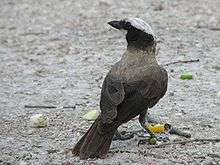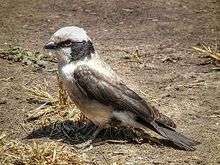Eurocephalus
Eurocephalus is a small genus of passerine birds in the shrike family. Just two species are placed in this genus.
| Eurocephalus | |
|---|---|
 | |
| Southern white-crowned shrike (Eurocephalus anguitimens) | |
| Scientific classification | |
| Kingdom: | Animalia |
| Phylum: | Chordata |
| Class: | Aves |
| Order: | Passeriformes |
| Family: | Laniidae |
| Genus: | Eurocephalus A. Smith, 1836 |
| Species | |
| |
_distr02.png) | |
Extant Species
| Image | Scientific name | Common Name | Distribution |
|---|---|---|---|
 | Eurocephalus ruppelli | Northern white-crowned shrike or white-rumped shrike | east Africa from south eastern South Sudan and southern Ethiopia to Tanzania |
.jpg) | Eurocephalus anguitimens | Southern white-crowned shrike or white-crowned shrike | Angola, Botswana, Mozambique, Namibia, South Africa, and Zimbabwe. |
These are large brown and white shrikes found in sub-Saharan Africa. They are gregarious species, unlike the Lanius shrikes, and have a parrot-like flight.
Eurocephalus shrikes are birds of savanna and open woodland habitats, typically seen perched upright on a prominent thornbush perch. These species primarily take large insects, but will occasionally eat fruit which has fallen to the ground.
The male and female are similar in plumage in both species but are distinguishable from immature birds.
gollark: Also also, "convention over configuration" being stupid. Yes, the choice of four spaces vs two isn't too significant, but being able to choose means you'll have code you can possibly read a bit more easily, and also public/privateness via *capitalization* just (in my opinion) looks ugly and is annoying if you want to change privacy.
gollark: i.e. generic slices/maps/channels but not actual generics, == being ***maaaaagic*** (admittedly like in most languages, I think), and `make`/`new`.
gollark: Also, as well as that, how it just special-cases stuff instead of implementing reusable solutions.
gollark: e.g. no map function existing or even being possible means that you have *readable* code with a for loop, but it's harder to understand *why that's there* and *what it's for*.
gollark: The main problem I have with it is that it conflates readability (you can see what the code is doing at a low level) with comprehensibility (you know what and why it's doing at a higher one).
References
- Tony Harris and Kim Franklin, Shrikes and Bush-Shrikes ISBN 0-7136-3861-3
This article is issued from Wikipedia. The text is licensed under Creative Commons - Attribution - Sharealike. Additional terms may apply for the media files.